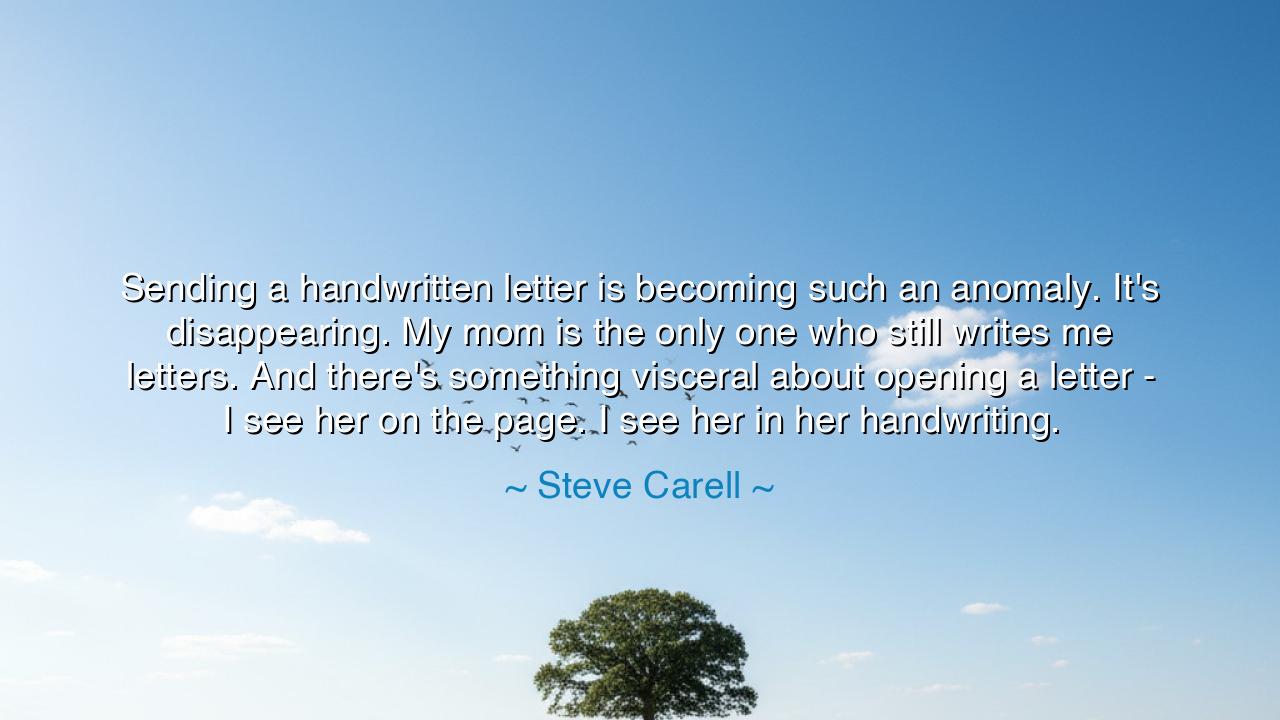
Sending a handwritten letter is becoming such an anomaly. It's
Sending a handwritten letter is becoming such an anomaly. It's disappearing. My mom is the only one who still writes me letters. And there's something visceral about opening a letter - I see her on the page. I see her in her handwriting.






When Steve Carell said, “Sending a handwritten letter is becoming such an anomaly. It’s disappearing. My mom is the only one who still writes me letters. And there’s something visceral about opening a letter — I see her on the page. I see her in her handwriting,” he spoke as one standing on the threshold between two eras — the age of touch and the age of screens. His words are more than nostalgia; they are a lament for a fading art form and a recognition of the intimate humanity that once flowed through pen and paper. In that sentence, he reveals a timeless truth: that in the strokes of a mother’s handwriting lies the very imprint of her soul — something no digital message can ever capture.
In the language of the ancients, what Carell describes would be known as the memory of the hand — the sacred bond between thought, heart, and gesture. To write by hand was once a ritual, an act of presence. The scribe did not simply record words; he inscribed emotion into form. Every curve of a letter, every smudge of ink carried breath, rhythm, and personality. Thus, when Carell opens a letter from his mother, he does not merely read her words — he feels her. Her handwriting becomes her voice made visible, her affection captured in tangible form. It is, as he says, “visceral” — of the flesh, living beyond mere language.
The origin of this quote arises from Carell’s reflection on modern communication and his appreciation for what is slipping away in a world dominated by speed. Known for his humor and humility, Carell often speaks of his family with reverence, grounding his reflections in simplicity and love. In this moment, he is not criticizing progress, but mourning the loss of the personal touch that once bound people closer together. In his mother’s letters, he finds continuity — a thread of connection to something slower, more deliberate, and deeply human.
In the days of old, letters were bridges across time and distance. The letters of Marcus Aurelius carried the meditations of a stoic emperor; the letters of Abigail Adams revealed the soul of a mother and wife during the American Revolution; and the letters of Vincent van Gogh to his brother Theo captured the pain and beauty of an artist’s life. Each was a conversation not bound by immediacy, but nourished by patience and reflection. When one waited for a letter, one waited not only for news but for presence — the tangible sign that someone had paused their life to think of you.
There is also, in Carell’s words, a lesson about impermanence and memory. Digital messages vanish with a swipe; they leave no scent, no texture, no trace of the hand that wrote them. But a letter endures. It yellows with time; it bears creases and fingerprints; it carries the faint perfume of the past. To hold such a letter is to hold history itself — the essence of love preserved in fiber and ink. In seeing his mother’s handwriting, Carell sees not only her words, but her being. Her hand moved where his now rests; her spirit lingers on the page. It is a moment where memory becomes physical, where love is made visible.
Consider the story of Helena, mother of Constantine the Great, who, in the early centuries of Christendom, wrote letters to her son as he rose to power. Those letters, though simple, were said to give him moral guidance — reminders of humility and compassion amid empire. Like Carell’s mother, Helena used the written word not merely to communicate, but to impart virtue. Each letter was a blessing, a way of touching the heart from afar. So too, every letter written by a parent is a kind of inheritance — wisdom pressed into paper, love made immortal by ink.
The lesson is clear: the written word is a sacred vessel of connection. Do not let it vanish. Take time to write, to hold the pen, to let your thoughts move through your body before they reach the page. Send letters to those you love — not to inform, but to connect. Teach your children the beauty of handwriting, the patience of putting thought into form. For in a world that races ever faster, the handwritten letter becomes an act of stillness, a rebellion of tenderness against the noise of convenience.
So remember, as Steve Carell reminds us: a letter is more than paper — it is presence. When you open a handwritten note, you do not merely see words; you see the person. You see the life that shaped the hand, the love that guided it, the memory that endures even when the voice is gone. Write, therefore, not only to communicate, but to be remembered. For when the screens fade and the messages disappear, the ink of the human hand will still whisper across time: I was here. I loved you.






AAdministratorAdministrator
Welcome, honored guests. Please leave a comment, we will respond soon